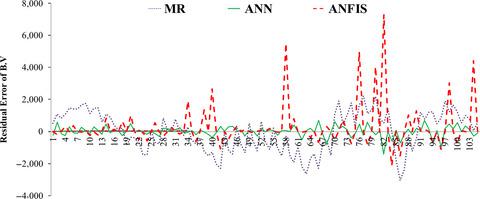当前位置:
X-MOL 学术
›
Food Sci. Nutr.
›
论文详情
Our official English website, www.x-mol.net, welcomes your
feedback! (Note: you will need to create a separate account there.)
Prediction of bruise volume propagation of pear during the storage using soft computing methods
Food Science & Nutrition ( IF 3.5 ) Pub Date : 2019-12-26 , DOI: 10.1002/fsn3.1365 Mahsa Sadat Razavi 1 , Abdollah Golmohammadi 2 , Reza Sedghi 3 , Ali Asghari 4
Food Science & Nutrition ( IF 3.5 ) Pub Date : 2019-12-26 , DOI: 10.1002/fsn3.1365 Mahsa Sadat Razavi 1 , Abdollah Golmohammadi 2 , Reza Sedghi 3 , Ali Asghari 4
Affiliation

|
Bruises occur under both static and dynamic loadings when the imposed stress on fruit goes over the failure stress of the fruit tissue. Bruise damage is the main reason for fruit quality loss. In this study, the potential of artificial neural network (ANN), adaptive neuro‐fuzzy inference system (ANFIS), and multiple regression (MR) techniques to predict bruise volume propagation of pears during the storage time was evaluated. For this purpose, at first, the radius of curvature at loading region was obtained. Samples were divided into five groups and subjected to five force levels. Then, they were kept under storage conditions and at 7‐time intervals after loading tests, bruise volume was calculated using magnetic resonance imaging (MRI) and image processing techniques. Force, storage time, and radius of curvature at loading region were employed as input variables, and bruise volume (BV) was considered as output in the developed models. Multilayer perceptron (MLP) artificial neural network with three layers that includes an input layer (three neurons), two hidden layers (two and nine neurons), and one output layer was used. For the evaluation of models, three criteria (RMSE, VAF, and R2) were calculated. ANN and MR gave the highest and lowest correlation between predicted and actual values, respectively. These results indicate that the ANN techniques can be used to predict pear bruising propagation in storage time.
中文翻译:

软计算方法预测梨贮藏期间瘀伤体积传播
当施加在水果上的应力超过水果组织的破坏应力时,在静态和动态载荷下都会发生擦伤。碰伤损伤是果实品质损失的主要原因。在这项研究中,评估了人工神经网络(ANN)、自适应神经模糊推理系统(ANFIS)和多元回归(MR)技术预测梨在储存期间瘀伤体积传播的潜力。为此,首先获得加载区域的曲率半径。样品分为五组并承受五个力级别。然后,将它们保存在储存条件下,并在加载测试后每隔 7 个时间间隔,使用磁共振成像 (MRI) 和图像处理技术计算瘀伤体积。在开发的模型中,力、存储时间和加载区域的曲率半径被用作输入变量,瘀伤体积(BV)被视为输出。使用具有三层的多层感知器(MLP)人工神经网络,包括一个输入层(三个神经元)、两个隐藏层(两个和九个神经元)和一个输出层。为了评估模型,计算了三个标准(RMSE、VAF 和R 2 )。 ANN 和 MR 分别给出了预测值和实际值之间最高和最低的相关性。这些结果表明,人工神经网络技术可用于预测贮藏期间梨瘀伤的传播。
更新日期:2019-12-26
中文翻译:

软计算方法预测梨贮藏期间瘀伤体积传播
当施加在水果上的应力超过水果组织的破坏应力时,在静态和动态载荷下都会发生擦伤。碰伤损伤是果实品质损失的主要原因。在这项研究中,评估了人工神经网络(ANN)、自适应神经模糊推理系统(ANFIS)和多元回归(MR)技术预测梨在储存期间瘀伤体积传播的潜力。为此,首先获得加载区域的曲率半径。样品分为五组并承受五个力级别。然后,将它们保存在储存条件下,并在加载测试后每隔 7 个时间间隔,使用磁共振成像 (MRI) 和图像处理技术计算瘀伤体积。在开发的模型中,力、存储时间和加载区域的曲率半径被用作输入变量,瘀伤体积(BV)被视为输出。使用具有三层的多层感知器(MLP)人工神经网络,包括一个输入层(三个神经元)、两个隐藏层(两个和九个神经元)和一个输出层。为了评估模型,计算了三个标准(RMSE、VAF 和R 2 )。 ANN 和 MR 分别给出了预测值和实际值之间最高和最低的相关性。这些结果表明,人工神经网络技术可用于预测贮藏期间梨瘀伤的传播。











































 京公网安备 11010802027423号
京公网安备 11010802027423号